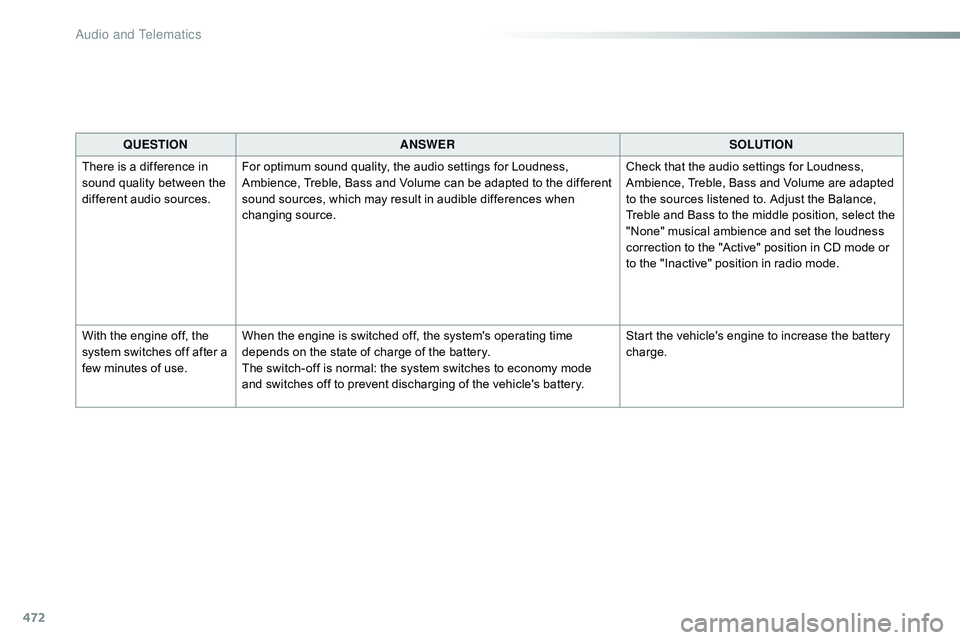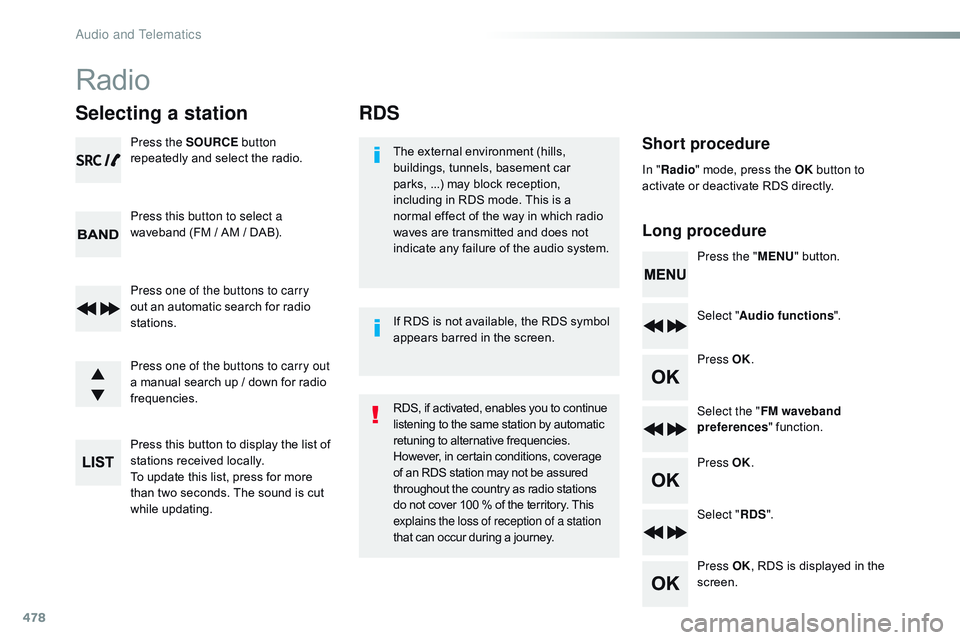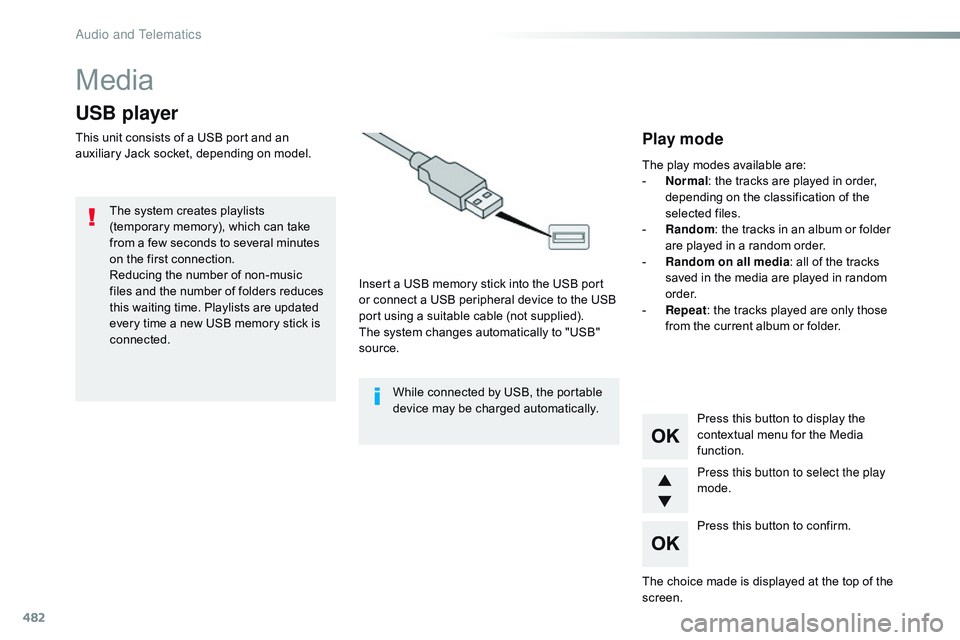2017 CITROEN DISPATCH SPACETOURER ECO mode
[x] Cancel search: ECO modePage 474 of 774

472
QUESTIONANSWER SOLUTION
There is a difference in
sound quality between the
different audio sources. For optimum sound quality, the audio settings for Loudness,
Ambience, Treble, Bass and Volume can be adapted to the different
sound sources, which may result in audible differences when
changing source. Check that the audio settings for Loudness,
Ambience, Treble, Bass and Volume are adapted
to the sources listened to. Adjust the Balance,
Treble and Bass to the middle position, select the
"None" musical ambience and set the loudness
correction to the "Active" position in CD mode or
to the "Inactive" position in radio mode.
With the engine off, the
system switches off after a
few minutes of use. When the engine is switched off, the system's operating time
depends on the state of charge of the battery.
The switch-off is normal: the system switches to economy mode
and switches off to prevent discharging of the vehicle's battery. Start the vehicle's engine to increase the battery
charge.
Audio and Telematics
Page 480 of 774

478
RDS
Short procedure
Long procedureThe external environment (hills,
buildings, tunnels, basement car
parks, ...) may block reception,
including in RDS mode. This is a
normal effect of the way in which radio
waves are transmitted and does not
indicate any failure of the audio system. Press the "MENU" button.
Select " Audio functions ".
Press OK.
Select the " FM waveband
preferences " function.
Press OK.
Select " RDS".
Press OK , RDS is displayed in the
screen.
In "
Radio " mode, press the OK button to
activate or deactivate RDS directly.
RDS, if activated, enables you to continue
listening to the same station by automatic
retuning to alternative frequencies.
However, in certain conditions, coverage
of an RDS station may not be assured
throughout the country as radio stations
do not cover 100 % of the territory. This
explains the loss of reception of a station
that can occur during a journey. If RDS is not available, the RDS symbol
appears barred in the screen.
Radio
Selecting a station
Press the SOURCE button
repeatedly and select the radio.
Press this button to select a
waveband (FM / AM / DAB).
Press one of the buttons to carry
out an automatic search for radio
stations.
Press one of the buttons to carry out
a manual search up / down for radio
frequencies.
Press this button to display the list of
stations received locally.
To update this list, press for more
than two seconds. The sound is cut
while updating.
Audio and Telematics
Page 484 of 774

482
Media
USB player
This unit consists of a USB port and an
auxiliary Jack socket, depending on model.Insert a USB memory stick into the USB port
or connect a USB peripheral device to the USB
port using a suitable cable (not supplied).
The system changes automatically to "USB"
source.
The system creates playlists
(temporary memory), which can take
from a few seconds to several minutes
on the first connection.
Reducing the number of non-music
files and the number of folders reduces
this waiting time. Playlists are updated
every time a new USB memory stick is
connected.
Press this button to display the
contextual menu for the Media
function.
Press this button to select the play
mode.
Press this button to confirm.Play mode
The play modes available are:
- No rmal: the tracks are played in order,
depending on the classification of the
selected files.
-
R
andom : the tracks in an album or folder
are played in a random order.
-
R
andom on all media : all of the tracks
saved in the media are played in random
o r d e r.
-
R
epeat : the tracks played are only those
from the current album or folder.
The choice made is displayed at the top of the
screen.
While connected by USB, the portable
device may be charged automatically.
Audio and Telematics
Page 488 of 774

486
The CD player can play files with .mp3, .wma,
.wav and .aac file extensions, with a bit rate of
of 32 to 320 Kbps.
It also supports TAG mode (ID3 tag,
WMA TAG).
Other file types (mp4, ...) may be played.
Files of the ".wma" type should be to
the wma 9
standard.
The sampling rates supported are 11, 22, 44
and 48 KHz.
File names should have less than
20
characters, avoiding special characters
(e.g.: " ? ; ù) so as to avoid any reading or
display problems. In order to be able to play a recorded CDR or
CDRW, the ISO 9660 level 1.2 or Joliet file
format is recommended when recording.
If the disc is recorded in another format, it may
not be played correctly.
It is recommended that the same recording
format is always used for an individual disc,
with as low a speed as possible (4x maximum)
for optimum sound quality.
In the particular case of a multi-session CD, the
Joliet format is recommended.
Information and advice
Use only USB memory sticks formatted FAT32
(File Allocation Table).
It is recommended that you use
genuine Apple
® USB cables for correct
operation.
Audio and Telematics
Page 492 of 774

490
During a call, press OK to display the
contextual menu.
In the contextual menu, select " End
call " to end the call.
Managing calls
Hang up
(so that the caller cannot hear)
In the contextual menu:
-
s
elect "Micro OFF " to switch off
the microphone.
-
d
eselect "Micro OFF " to switch
the microphone on. In the contextual menu:
-
s
elect "
Telephone mode " to
transfer the call to the telephone
(for example, to leave the vehicle
while continuing a conversation).
-
d
eselect "
Telephone mode " to
transfer the call to the vehicle.
Microphone off Telephone modeIf the contact has been cut off, when you
reconnect on returning to the vehicle,
the Bluetooth connection will be restored
automatically and sound returned to the
system (depending on the compatibility of the
telephone).
In some cases telephone mode must be
activated from the telephone. From the contextual menu, select
"
DTMF tones " and confirm to use
the digital keypad to navigate in the
interactive voice response menu.
From the contextual menu,
select
"
Switch " and confirm to return
to a call left on hold.
Interactive voice response
Dual call
Confirm with OK.
Confirm with OK. Confirm with OK.
Confirm with OK.
Confirm with OK.
Audio and Telematics
Page 494 of 774

492
The table below gives answers to the most frequently asked questions on your audio system.QUESTION ANSWER SOLUTION
With the engine off, the
audio system switches off
after a few minutes of use. When the engine is switched off, the audio system operating time
depends on the state of charge of the battery.
The switch-off is normal: the audio equipment switches to economy
mode and switches off to prevent discharging of the vehicle's
battery. Start the vehicle's engine to increase the battery
charge.
The message "the audio
system is overheated"
appears on the display. In order to protect the installation if the surrounding temperature
is too high, the audio system switches to an automatic thermal
protection mode leading to a reduction in volume or CD play
stopping. Switch the audio system off for a few minutes to
allow the system to cool.
Frequently asked questions
QUESTION
ANSWER SOLUTION
There is a difference in
sound quality between the
different audio sources
(radio, CD...). For optimum sound quality, the audio settings (Volume, Bass,
Treble, Ambience and Loudness) can be adapted to the different
sound sources, which may result in audible differences when
changing source (radio, CD...). Check that the audio settings (Volume, Bass,
Treble, Ambience and Loudness) are adapted to
the sources listened to. It is advisable to set the
audio functions (Bass, Treble, Front-Rear Balance
and Left-Right Balance) to the middle position,
select the musical ambience "None" and set the
loudness correction to the "Active" position in CD
mode or to the "Inactive" position in radio mode.
Radio
Audio and Telematics
Page 495 of 774

493
QUESTIONANSWER SOLUTION
The preset stations do
not
function (no sound,
87.5 Mhz is displayed...). An incorrect waveband is selected.
Press the BAND AST button to return to the
waveband (FM, FM2, DAB, AM) on which the
stations are preset.
The traffic announcement
(TA) is displayed. I do
not receive any traffic
information. The radio station is not part of the regional traffic information
network.
Tune to a radio station which broadcasts traffic
information.
The quality of reception of
the radio station listened
to gradually deteriorates
or the stored stations do
not function (no sound,
87.5
Mhz is displayed...). The vehicle is too far from the transmitter used by the station
listened to or there is no transmitter in the geographical area
through which the vehicle is travelling.
Activate the RDS function to enable the system
to check whether there is a more power ful
transmitter in the geographical area.
The environment (hills, buildings, tunnels, underground car parks...)
block reception, including in RDS mode. This phenomenon is normal and does not indicate
a fault in the audio system.
The aerial is absent or has been damaged (for example when going
through an automatic car wash or into an underground car park). Have the aerial checked by a franchised dealer.
Sound cut-outs of 1 to
2
seconds in radio mode. During this brief sound cut-out, the RDS searches for another
frequency giving better reception of the station. Deactivate the RDS function if the phenomenon is
too frequent and always on the same route.
.
Audio and Telematics
Page 499 of 774

497
D
E
Checks ..........................................272, 276, 277
Child lock, electric, manual
...............
......................................... 19 0
Child lock on rear windows
...................................................... 19
1
Children
...............................
... 167, 170, 173 -191
Children (safety)
...............................
.............19 0
Child seats
..............................
......................180
Child seats, conventional
........................................ 17
9 -18 2
Child seats, ISOFIX
..............................18
4 -18 6
C
ITROËN
C
onnect Box
...............................32
8
CITROËN Connect Nav
................................ 3
31
CITROËN Connect Radio
.............................41
9
C
ITROËN
L
ocalised
Emergency Call
..................................1
58, 328
Closing the boot
...............................
... 76, 79, 81
Closing the doors
...............................
.......65 -78
Coat hook
...................................................... 11
5
Collision risk alert
....................2
1, 239 -241, 243
Compressor, tyre inflation
............................28
5
Connection, Bluetooth
..... 3
70, 396 -398, 426, 452- 454, 488
Connection, MirrorLink
............................3
72, 374, 428, 430
Connection, Wi-Fi network
..............................
....... 371, 427
Connectivity
...............................
...........368, 424
Control, emergency
boot release
...............................
...................81
Control, back-up door
...............................5
0, 60
Control, heated seats
................................ 9
1, 94
Control stalk, lighting
.................................... 14
4
Control stalk, wipers
..................................... 15
4
Courtesy lamp, front
..................... 1
40, 307, 310
Courtesy lamp, rear
...................... 1
40, 307, 310
Courtesy lamps
............................. 1
40, 307, 310
Cover, load space
................................. 11
5 , 118
Cruise control
................................................ 2
28 Doors ..............................................................
.65
Doors, rear
............................... .......................79
Doors, side-hinged
.......... 5
7, 58, 61, 79, 80, 305, 306
Driver’s attention warning
...............................
........................247
Driver's door open warning
...............................
.................... 18, 72
Driving abroad ............................................... 146
Driving economically ....................................... 11
Driving time warning
............................. 2
47, 248
Dynamic stability control (DSC)
............................................ 2
3, 159, 161
DAB (Digital Audio Broadcasting) - Digital radio
................................ 3
86, 442, 480
Date (setting)
...............................
....44, 410, 466
Daytime running lamps
......... 1
44, 147, 299 -301
Deactivating the passenger
airbag
.................................................. 17
0, 176
Deactivation of DSC (ESC)
...............
...........................................161
Deadlocking
...............................
........ 48, 53, 58
Demisting, defrosting, front
..........................13
1
Demisting, defrosting, rear
........................... 13
2
Diagnostic system, engine
...............
............................................19
Dials
...............
........................................... 13, 14
Diesel
...............................
.............................263
Dimensions
..............................
.....................323
Dipstick
................
....................................32, 273
Direction indicators
...........1
46, 299, 302, 303, 305, 308
Display, head-up
........................................... 2
18
Display screen, instrument panel
............................. 1
3, 14, 204
Door pockets
.................................................11
2EBA
.............................................................
..159
Eco-driving (advice)
........................................ 11
E
lectronic brake force
distribution (EBFD)
..................................... 15
9
Emergency call
.....................................1
58, 328
Emergency warning lamps
...................1
58, 282
Emissions control system, SCR
..............................
........................25, 278
Energy economy mode
.................................26
6
Engine compartment
.................................... 2
72
Engine, Diesel
........ 1
9, 263, 272, 322, 325, 326
Environment
................1
1, 51, 62, 132, 133, 134,
138, 209, 258, 275, 280, 316
ESC (electronic stability control)
............2
3, 159
Cruise control, dynamic
................................2
32
Cruise control by speed limit recognition
.................................................. 2
23
Cup holder
...............................
......................115
.
Alphabetical index